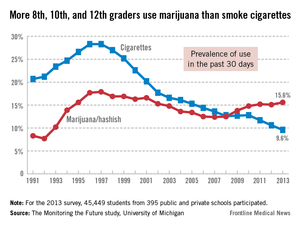High school students are becoming more accepting of marijuana use, according to findings from the 2013 Monitoring the Future survey. This year’s survey results, released Dec. 18, show that 39.5% of 12th graders view marijuana use as harmful, down from last year’s rate of 44.1%.
The annual survey also reports a rise in marijuana use, compared with past decades, with 6.5% of high school seniors smoking daily, up from 6% in 2003 and 2.4% in 1993. Past-month use of marijuana increased between 2008 to 2013 from 5.8% to 7% among 8th graders, from 13.8% to 18% among 10th graders, and from 19.4% to 22.7% among 12th graders.
Dr. Nora D. Volkow, director of the National Institute on Drug Abuse, said this increase is quite worrying because of the potential effects on developing teenagers’ learning and memory.
"They are more sensitive to the effects in the brain," Dr. Volkow said in a teleconference announcing the results of the survey. "These are very high numbers, because these kids are in school and may be unable to learn properly."
Lloyd D. Johnston, Ph.D., lead investigator of the survey, said the changes in attitude might be related to easier access to pot as a result of medical marijuana legalization in some states, and the recent legalization of recreational marijuana in Colorado and Washington states.
"Medical marijuana and legalization affect perceived risk and prevalence of use," said Dr. Johnston of the University of Michigan’s Institute for Social Research. High school students also might be obtaining the drug through a friend or relative’s medical marijuana prescription, he added.
R. Gil Kerlikowske, director of the Office of National Drug Control Policy, expressed disappointment about the findings about teenagers’ increased use of marijuana. "More teens are now smoking marijuana than smoke cigarettes," he said.
The survey also shows a steady decrease in two areas: cigarette smoking and alcohol abuse. Cigarette use among 8th graders dropped to 14.8%, down from 15.5% in 2012. In 10th and 12th graders, cigarette use decreased from 27.7% to 25.7% and from 39.5% to 38.1%, respectively.
"Needless to say, the decline in cigarette use is very important," Dr. Johnston said. "We’re still seeing progress."
He added that newer drugs, such as bath salts and synthetic marijuana (also known as Spice or K2), were a cause for concern last year, but that recent media coverage has attracted attention to their adverse effects.
"There’s always a concern about new trends," Dr. Johnston said. "It seems the questionnaires get longer every year because there are so many drugs now, and unfortunately, not many leave the scene."
Synthetic marijuana use among high school seniors decreased from 11.3% in 2012 to 7.9% in 2013, and perceived risk of harm of using bath salts increased from 33.2% in 2012 to 59.5% in 2013.
This increased risk awareness is promising, Dr. Johnston said. "I think it’s important that we’ve seen a turnaround."
Abuse of prescription painkillers decreased this year, with Vicodin use among high school seniors dropping from 7.5% in 2012 to 5.3% in 2013. The increased abuse of prescription stimulants such as Adderall, however, continues to be a cause for concern, with 8.7% of 12th graders using amphetamines for nonmedical reasons in 2013, up from 6.8% in 2008.
"These drugs are used not just to get high and have fun, but also to improve performance," Dr. Volkow said. "So they take it prior to exams."
Cocaine and heroin use, though not significantly different from 2012 rates, continue to see a drop in use and currently are at a historic low in all grades. Only 2.6% of high school seniors reported cocaine use in 2013, compared with the peak rate of 6.2% in 1999. Heroin use was even lower, with 0.6% reporting use this year, compared with a peak of 1.5% in 2000.
Inhalants, more likely to be abused by younger students, also saw a decrease, with 5.2% of 8th graders reporting use.
Mr. Kerlikowske of the drug control policy office, said he hopes drug prevention programs in schools and communities will help curb abuse of marijuana in the future. "This should concern every parent, teacher, and employer across the nation," he said. "I continue to call upon all of us to bolster education."
This year’s Monitoring the Future survey featured more than 41,000 participants from 389 public and private schools. Survey participants are asked to report past month, past year, and lifetime use for each drug in the questionnaire. The survey has measured drug use and attitudes in high school seniors since 1975. Eighth and 10th graders were added in 1991.




